In the previous money rant, I finally addressed Lesson Nine from this list of potential rants. It’s time to move on to a more positive one. Let’s talk about a time when America had its shit together, The Great Depression. No, really. I’m not kidding.
Much as we may deride President Woodrow Wilson for other very racist things, the League of Nations was a great progressive idea. Unfortunately, Great Britain and France wanted to see Germany burn at the end of World War I, so it all fell apart promptly. It’s understandable but the American government was left throwing its hands in the air and saying, more or less to quote Cartman, “Screw you guys, I’m going home.” Admittedly, a Congress that felt that America had no business in Europe, other than Business, had no interest in it. Also, they wanted their war loans that they gave to the Allies paid back; a creditor/debtor relationship does not make for good international relations. But that doesn’t mean that the machinery of American government wasn’t looking around and paying attention. Okay, to be fair, it didn’t do much until FDR got into office. The Harding, Coolidge and Hoover administrations were, in short, pretty excited about things going on in America and hegemony in the Caribbean, less so further afield.
But come 1933, by my general feel of history, an American generation that had not been listened to during and in the wake of WWI found itself in power and said collectively to themselves, “Let’s not do that again. Also, this Depression sucks.” There may also have been a glance over toward Europe with a wince and the pained teethsucking noise of “Oooo, ouch. Well, at least we aren’t Europe. We tried to tell ’em. This Hitler guy seems to be a bit of a dick and, MAN, do we not like what Japan is up to over there. They better not fuck with the Philippines, we just finished pacifying that a little while ago. Invented ridiculously high caliber guns to do it and everything.” While trying to figure out a way out of the hole America had fallen into and fix the myriad problems, the New Deal bureaucracy FDR’s administration assembled was thinking big. Beyond the borders of America big. How to win the peace of the next war big.
Since you’ve read this far it shouldn’t come as big surprise the answer to this was money.
The idea they came up with was called Provisional Currency*. Cash that the United States could bring with them to a war theater and instantly reconstitute an economy that we could participate in and bring into the American sphere of influence. Oh sure, it would obliterate the previous economy that was there but the US Army isn’t completely dim, they would happily exchange any of the the old precious metal currency that may have remained for the Provisional Currency. But more importantly, if the US lost and had to abandon territory (unthinkable!!!) this was currency that was different than normal domestic US legal tender which could be disavowed. We could easily say “Things that look like $QUALITY? NOPE, those aren’t valid anymore. You sure do have a lot of these, Mister… [reads passport closely] Berwin Rommelle?”
Let’s have a compare and contrast moment starting with a pre-Monopoly money five dollar bill.
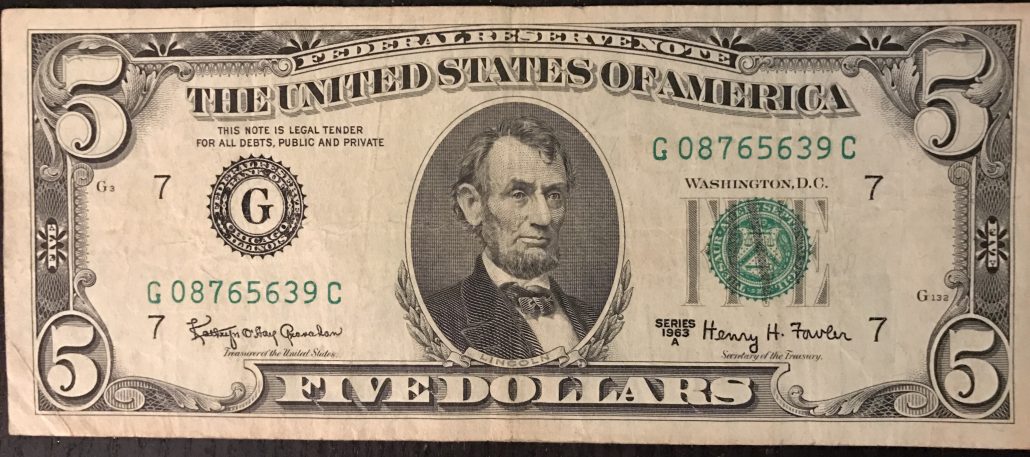
Please note the specific wording used on this bill. It is a “Federal Reserve Note” worth “Five Dollars” and “This Note Is Legal Tender For All Debts, Public And Private”. I don’t want to start a fiat currency argument here, but let’s just leave it at this bill is worth five bucks but it’s some what nebulous what exactly a dollar is. Prior to 1964 and the demonetization of silver, we had had another kind of bill called the silver certificate. This bill was worth its stated value but you could exchange it for an equivalent amount of legal tender in silver, i.e. coins. While I don’t have a crisp normal five dollar silver certificates in my collection, I do have a one dollar silver certificate.
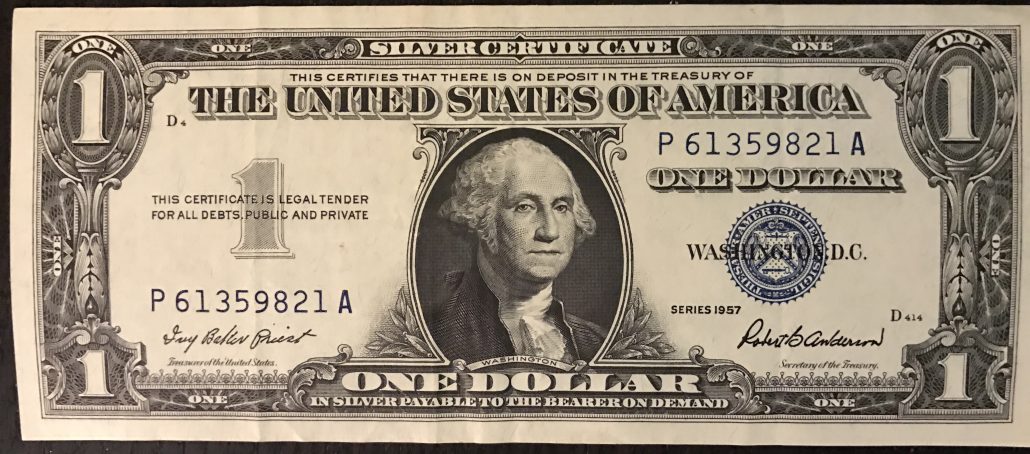
While the statement about legal tender is there, you can see some differences. First off, rather than saying “Federal Reserve Note” it has “Silver Certificate” at the top. Instead of just declaring ‘The United States of America”, in case you forgot which nation would put Lincoln and Washington on its money, the words “This Certifies That There Is On Deposit In The Treasury Of” above it to make a leading statement that continues with the additional words below. Instead of just saying “One Dollar”, we also promise “In Silver Is Payable To The Bearer On Demand”. The earliest versions of the silver certificates were missing the statement about deposit with the Treasury which, technically, meant every single bank had to maintain sufficient silver on hand to cover every yahoo that wanted sacks of coins rather than bills. This lead to all kinds problems, hence the change, but that’s a different story that involve bank runs, bankruptcies, bank robberies and other phrases that involve the word bank. But the most plain difference between the two different kind of bills was the color of the seal and serial number: federal reserve notes were green, silver certificates were blue. Similar to the silver certificates, there had been gold certificates with a yellow seals and serial numbers, but gold was demonetized in 1933 and the gold certificates discontinued. This meant that in 1934 the color yellow was available to use to do this.
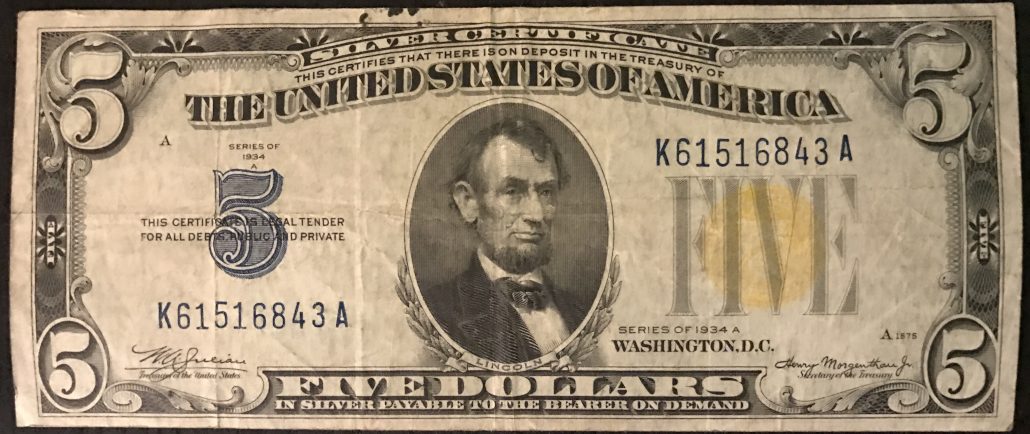
The appearance of this bill is inconsistent. You have all the silver certificate language. You’ve got serial numbers done in blue, like a silver certificate should have, but then you’ve got this giant yellow seal like it should be a gold certificate. In short, it’s weird and sticks out like a sore thumb in any stack of money. As long as we all agree it’s valid money, it’s valid, but it’s really easy to tell people what to confiscate/ignore if you disavow it. This is the original Provisional Currency that the United States printed up in preparation for the next time they had to occupy a country and had it available in $1, $5, and $10 denominations. Please take a moment and look at the year.
Yes, that’s right. You read that correctly.
NINETEEN FUCKING THIRTY FOUR! WE HAD THIS READY FOUR YEARS BEFORE THE FUCKING NAZIS ANNEXED AUSTRIA, MUCH LESS ANYTHING ELSE. SEVEN YEARS BEFORE GODDAMN PEARL HARBOR.
[takes to deep breath and a swig of bourbon to calm down]
Not that we actually used them until 1943 after Gen. Patton landed in North Africa, which is why the yellow seal silver certificates are colloquially known as North African bills. As the story goes, the first wave of landing ships dropped off Patton and his tanks and the second wave brought the pallets of cash. I don’t believe that for a second, but it’s a nice story. Actually, the funny thing is that they’re known as North African bills and not Reconstruction bills because there was a diplomatic rift about whether to use them in an increasingly liberated France. Use ’em in Africa and Italy? No problem. France? SACRE BLEU, NON! As an empirehaver that intended to get its empire back once this “small German embarrassment” was resolved, France wanted to make sure the Francophone world that looked to Paris for authority also recognized the supremacy of the Franc, so no yellow seal bills for France.
But those are all game time decisions when you roll the Provisional Currency out. The fact of the matter is that we had it and had been sitting on the final printed product for almost a decade before using it. We were ready. We had the experience, we knew how the economy got disrupted in war, and we knew how to start putting things back together and make friends (okay, that term might be a bit strong) while doing it. Even if you take the usual black market and profiteering into account, they’re working with with the currency and formal markets we created because nothing else works at the moment and that, sort of, makes even the criminals our allies. Rather than pillaging the treasuries of conquered lands and replacing their money with pot metal, which is what the Nazis & Fascists did everywhere they went and their Occupation Currency coins are fucking garbage pot metal, we dropped a limited functionality Army-driven American economy on them. When you stack things like the much grander Marshall Plan on top of this after the war is over, you start to marvel that America used to have an incredibly competent leadership across the entire span of government in career, appointee and, yes, even elected positions that earned the respect of the entire world.
…and then you look at Vietnam, Afghanistan, and Iraq and ask what the hell happened? We walked into Iraq with the assumption oil revenues, oil that wasn’t America’s, would pay for everything. We took planeloads of cash to Iraq & Afghanistan to nominally rebuild them, which mostly vanished back into the coffers of American contractors, sucking the air out of the local economies rather than rebuilding them. How did we clearly learn the lessons of how to win the peace and then forget them so quickly?
I don’t know the answer to this question but I like to look at my yellow seal $5 silver certificate and remember “Once upon a time, America knew how to plan.”
*: Okay, America wasn’t the only nation that thought up provisional currencies but we were the only one that decided to put the full faith and credit of the nation behind it. In fact, America had two provisional currencies, though the second one was a little less planned.
On the other side of the world from North Africa, after Pearl Harbor there was a bit of an “Oh shit” moment with respect to Hawaii as the powers that be considered the real possibility of Japanese invasion of the islands, in particular that this would mean they’d get to seize all the American currency that was there. In January 1942, most all paper currency was withdrawn from the islands with strict limits placed on how much individuals ($200) and businesses ($500, other than payroll) could possess. By June, bills from the San Francisco Federal Reserve Bank showed up freshly stamped with the words “HAWAII” in a particularly unsubtle manner on the front and back with a red seal**. After they showed up, it became illegal to use currency in Hawaii that wasn’t stamped. Just like the yellow seals, if the Japanese managed to capture the islands, all bills stamped “HAWAII” could be disavowed.
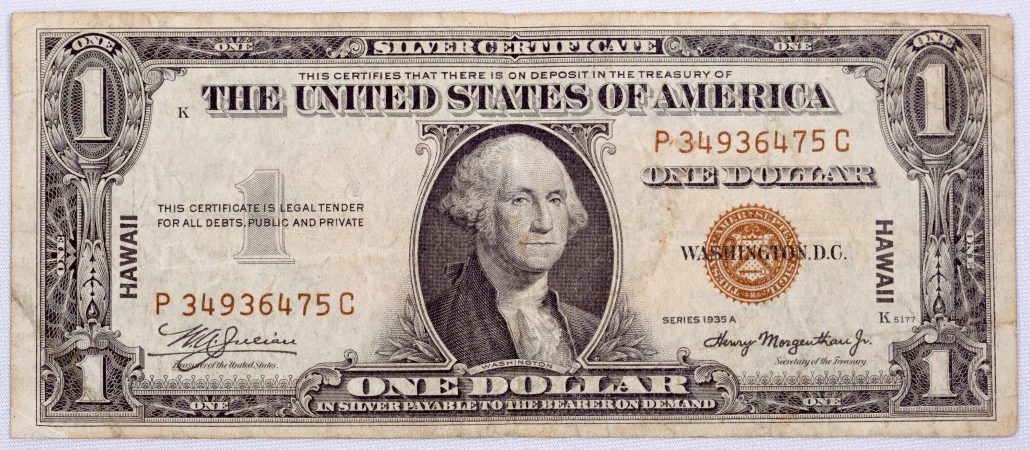
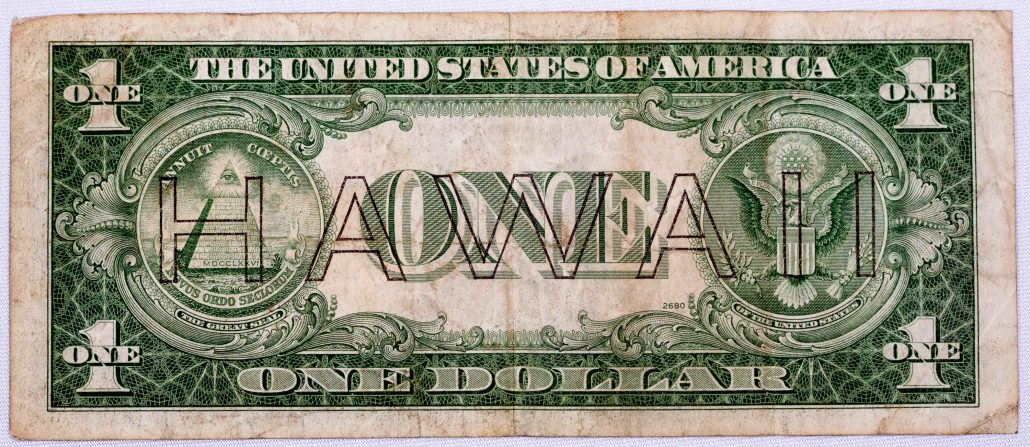
But why didn’t they just use the already made Provisional Currency with the yellow seals in Hawaii? I don’t know the actual justification but I can think of a few reasons. First, they were intended to reconstitute an entire country not, don’t take offense Hawaiian readers, what was at the time a lightly populated island chain of strategic importance but with a comparatively tiny economy. Secondly, and I think more important as I put all scenarios through my Lazy/Horny/Greedy Filter of Human Motivations, the yellow seals were on the wrong side of the Rockies from Hawaii. Much easier to just go grab some of the cash sitting in unused in the vaults in San Francisco and just stamp HAWAII on them than load the yellow seals up on trains, send them west, and then ship them from SF to Hawaii.
After the war was over, they were demonetized and most were burnt, rather than shipped to the mainland for destruction, in the local crematorium and the furnaces of the Aiea sugar mill as fuel. These days, it’s a point of pride in the islands to own any of the old stamped bills.
**: Please don’t ask me to explain where the red seal came from. That is a very ugly discussion in it’s own right and we are well rid of the United States Notes.